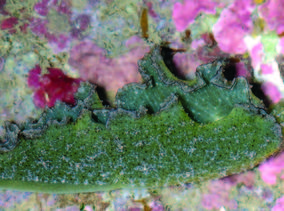You are here
Sacoglossa
Elysia subornata A. E. Verrill, 1901
Nomenclature
-
Family: PlakobranchidaeGenus: Elysia
SUMMARY
"Specimens with single population were often highly variable in coloration, ranging from yellow green to dusky olive to reddish, usually with brownish to black parapodial margins (pale or absent in some specimens). Parapodial margins thickened, whitish. Parapodia usually minutely papillose, sometimes smooth; heavily ruffled in larger specimens. Parapodia often bear white spots, with or without black rings. Rhinophores usually banded with irregular transverse grey or white band, with distal transverse brownish band. Small juveniles show the distinctive black "facial mask" described for Florida specimens (Clark et al., 1979). Renopericardium long (ca. 1/2 total body length), extending most of the distance to tip to tail, with about 10 vessels extending perpendicularly from each side to the base of the thickened parapodial margin, branching more or less dichotomously, sometimes anastomosing. Radular tooth minutely denticulate. Body length to 50 mm; on of the largest Atlantic ascoglossans. Comment: the range of variation of the specimens collected here includes all characteristics of Verrill's (1901) brief description and figure (except that the marginal line of the parapodia is rarely orange-brown) and does not significantly differ from characteristics of Elysia cauze. The marginal black band is a character found in several described and undescribed Caribbean and Florida Elysia, but as Marcus (1980) notes, the long renopericardium and the dorsal vessel pattern, "are an exceptional feature of the species." Although Bermuda animals are more variable in color than Florida populations, there seems no valid reason to regard them as a distinct species." (Clark, 1984, Nautilus 98(2) p. 88-89)
Note on taxonomy: This species was originally called Elysia cauze before Clark's informal synonymy reproduced above; this appears to have been treated as an official synonymy by most workers (but see Valdes 2006).






